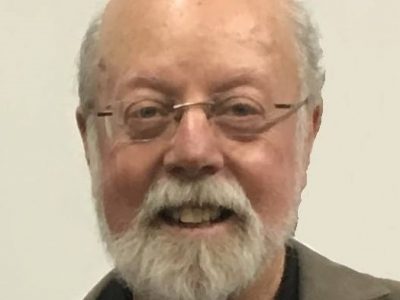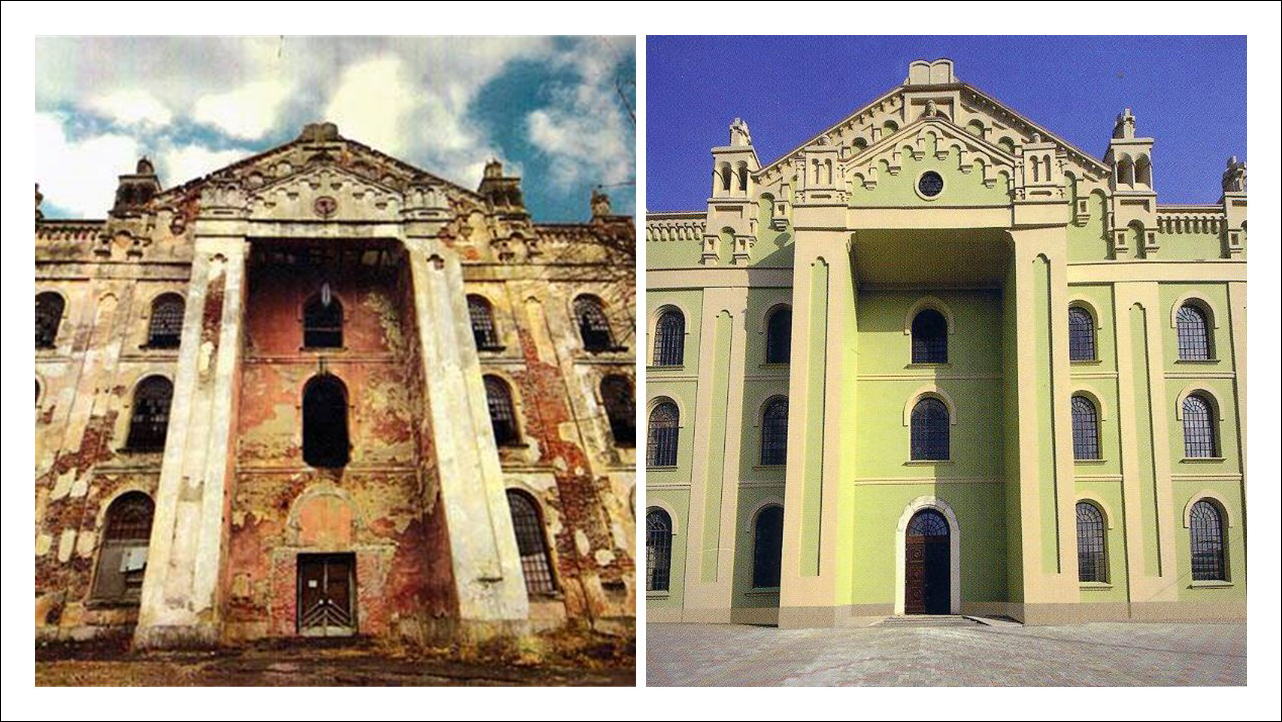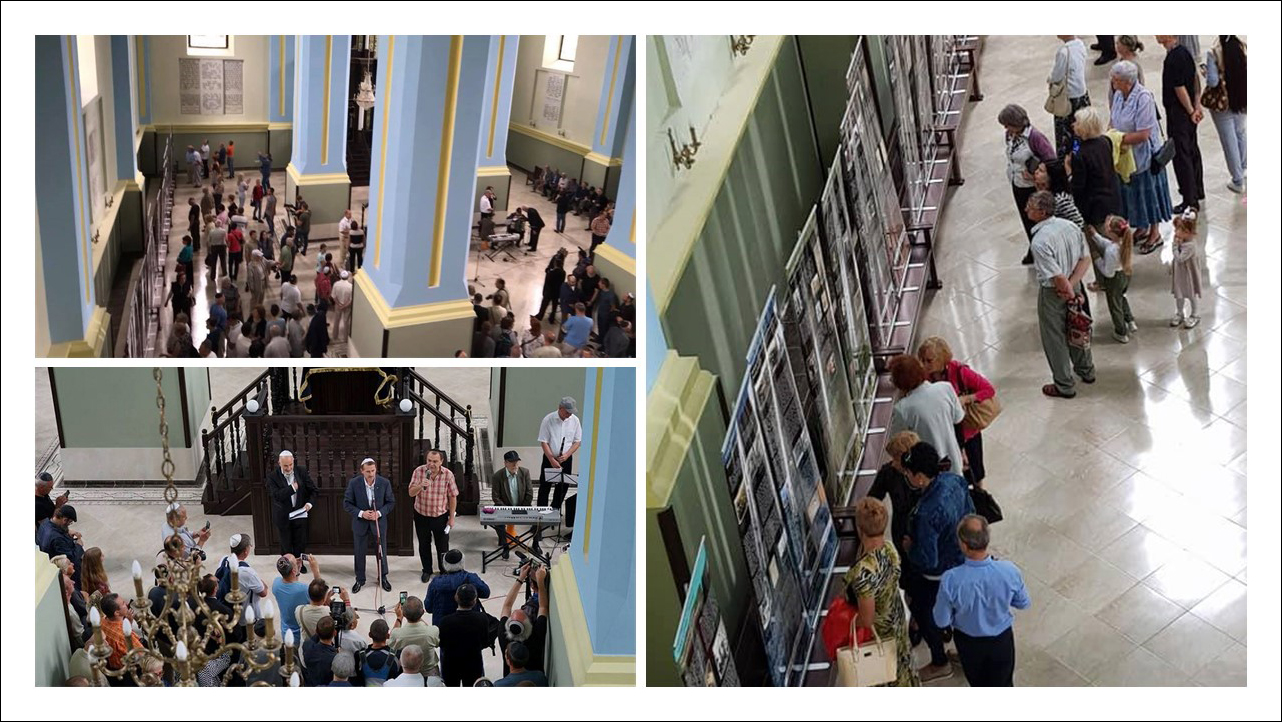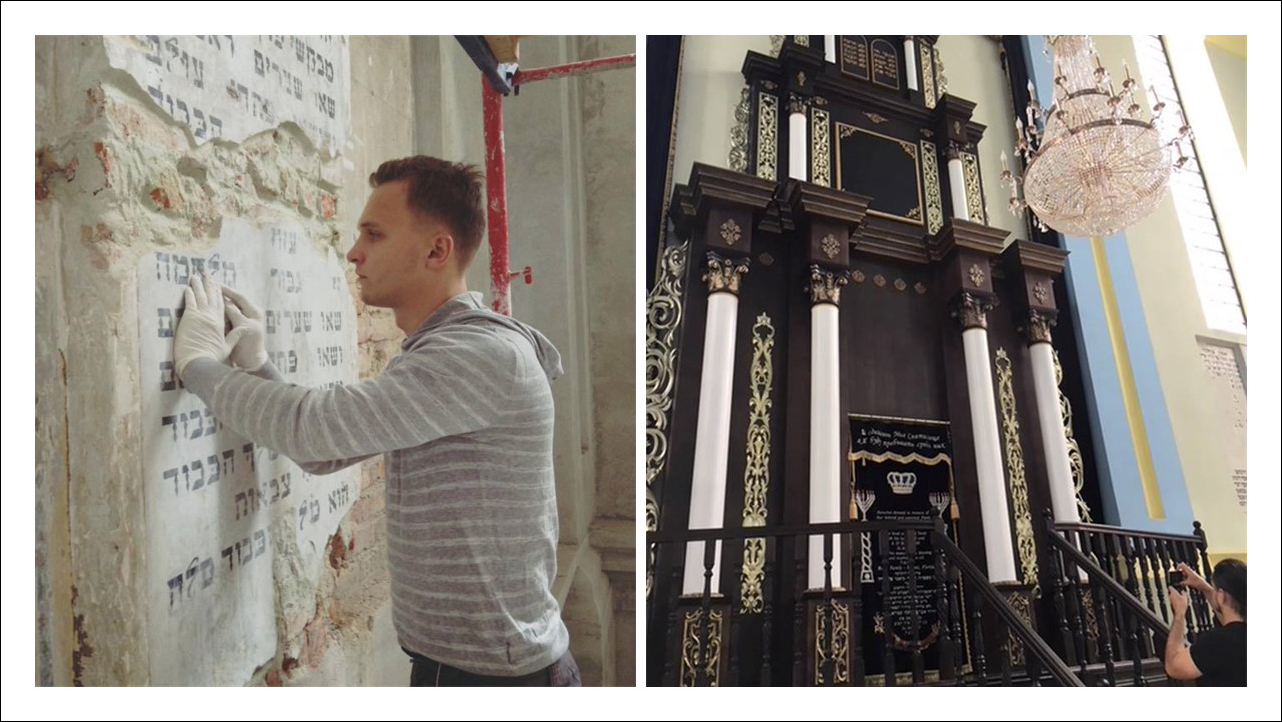Interview with Dave Bloom
Dave Bloom is a member of the board of an organization dedicated to preserving the story of two Jewish communities and surrounding areas in Ukraine. One of them is called Drohobycz and the other is called Boryslaw.
Recently a synagogue was restored in this area and Dave has kindly agreed to join us by Skype from his home in Israel to tell us about himself and about the project.
Pawlina: So welcome Dave. Thank you for joining us.
Dave Bloom: Thank you for having me on your show.
Pawlina: Now you live in Israel. Tell us a little bit about your background…how you ended up on this project and in Israel. Because you speak (almost) unaccented English!

Dave: Well my personal story is that I was born in what is now Zimbabwe, previously Rhodesia. I came to live in Israel in 1973 and I’ve been here since then. I’m married with two children and I’ve been always interested—fascinated—in researching my roots. It’s actually my mother’s side—my maternal grandparents—who were born in Boryslaw, which is one of the towns that we’ve mentioned. My mother was born there as well. They came here to Israel, actually, in 1920. So my mother grew up in Israel. But I always had a fascination about the story of those communities where my grandparents came from. I’ve been back there a few times. It’s a hobby of mine. And I’m on the board of this organization which helps to preserve the stories of these two towns and the surrounding villages. There’s a number of villages like Stryj, and Schodnicza and Truskavetz, which we also try to preserve their stories.
Pawlina: Fascinating! So how we got connected on Facebook …might have been something from Marla Raucher Osborn who’s been on our program talking about her restoration work in Rohatyn, which I think is pretty close?
Dave: Well it’s bit further north. It’s about an hour north of our area. Yes.
Pawlina: So you have always been interested in your roots. What connected us was this story about the restoration of a synagogue in Drohobycz. So tell us about that.
Dave: I’ve seen this synagogue on my visits over the last about ten years, and it was in a really sorry state. It was really a ruin of a building that had been basically destroyed during the second world war. And of course, when the whole Russian control over Ukraine during those many years which did not allow religious activity … the building was left to basically ruin. I think at some stage it was used as a warehouse.
Pawlina: Like churches were. Yes.
Dave: This is a very impressive building that was built in the 1860s. This was one of the largest synagogues in Galicia. Galicia was, as you know, a large stretch of land spanning what is now Poland and Ukraine. There were about a million Jews in the area of Galicia in the 19th and early 20th centuries. Drohobycz I believe had if not the largest synagogue then the largest in the area. So in the last five years, with some generation donations, a refurbishment program started and it came to fruition this week. We had a ceremony [last year], a very impressive ceremony, a somber ceremony in which several hundred people attended, from Israel, from America, from the local communities, from Lviv, and basically re-inaugurated this wonderful building. The work has been fantastically done. It has all the infrastructure for a synagogue with the Ark and the bimah.
Pawlina: What’s that?
Dave: That (bimah) is where the Rabbi normally stands and that’s where he prays from.
Pawlina: OK.
Dave: It’s unlikely to be an active synagogue because there’s very few Jews left in the city. But the plans are to turn it into a cultural centre, into a learning centre, into a museum. And we’re hoping this will help to bring the story of the Jewish community that lived there for many hundreds of years, will help to educate the local communities about the story of the Jewish community there. And we have plans ourselves…we’ve done a couple of exhibitions. One of them was shown at the event, the opening event, telling the story of these communities. We hope it will be a vehicle for education. I think that’s it’s main purpose.
Pawlina: So tell us what actually to it, that you had to restore it. You had mentioned that it was a warehouse, or just basically neglected during the Soviet era, and of course that was the fate of all churches and houses of worship throughout the Soviet Union. But what happened to the community? We’ve been talking about this with Marla and others…Julia Korsunksy of RememberUs.org. You probably are aware of that organization as well. So a lot of people are getting back to their roots and are exploring what actually happened to their families. Most of the Holocaust took place by bullets in that area, as much as in death camps.
Dave: Sure.
Pawlina: Although I was reading on your website that many of the residents of Drohobycz perished at Belzec, a notorious death camp.
Dave: Yes, that’s right. The vast majority were sent by train to Belzec, which is just a few hours’ train ride. I’ve been there a couple of times. It’s a really horrific story. It’s a pure death camp. The people came in and they were slaughtered as they arrived.
Pawlina: Good Lord.
Dave: There is a site in what’s called the Bronicki forest, outside Drohobycz, where Jews were also taken and lined up, and killed. They had to dig the trenches first and then they were shot and buried in these trenches. This is a large memorial site now which is being preserved and has been covered over, and we visit there every year. We do a memorial service there as well. Many thousands were killed in the forests around Drohobycz and Boryslaw. But the vast majority were taken by train on an industrial scale and murdered at Belzec.
Pawlina: Good Lord. How big was the community before the Holocaust?
Dave: In 1939 Drohobycz was about 17,000 Jews, and Boryslaw was about 14,000 Jews. And at the end of the war, in 1945, approximately 550 survived in Drohobycz and about 350-400 survived in Boryslaw.
Pawlina. Wow, and I can just imagine the trauma…
Dave: Indeed. And what is at least for us inspiring is that we have been able to find a lot of these survivors, many of whom came to Israel. And now when we have an annual memorial service, we have 1000 people attending. And we see the children and grandchildren involved and connected, and there is a feeling of continuity, which is very inspiring.
Pawlina: Yeah, and that’s what was meant to be destroyed, wasn’t it? So…
Dave: Absolutely.
Pawlina: That’s wonderful to hear. So how did you hook up with people in Drohobycz? Was it just on a trip? You’ve got awfully strong connections because you’re so involved.
Dave: Well you know we have over the years been in touch through our roots trips. We’ve had roots trips going back since the 1960s.
Pawlina: Oh. Really?
Dave: Yes. I’ll give you our website afterwards and you can see some of those more recent roots trips that we have recorded. The earlier ones unfortunately were not well recorded. But there was always a relationship with the remnants of the community. Now the remnants were very, very sparse. There was one famous gentleman by the name of Alfred Shreyer, who was a famous musician, a singer, and a violinist. And he was kind of denoted as the “last Jew of Drohobycz.” I met him on a couple of occasions, and he was well-connected with our organization. Every time we came, we would connect with him. Unfortunately, he passed away a few years ago. But today there are approximately 20 or 30 Jews in Drohobycz, and most of them migrated there from Russia. They are not native to Drohobycz, but most of them migrated and have established their lives in Drohobycz for all kinds of reasons.
Pawlina: Interesting so few of the original inhabitants actually have descendants there now.
Dave: Very few. We don’t know of any, actually.
Pawlina: Really. Wow. So it was wiped out. Amazing.
Dave: Yes, it was wiped out.
Pawlina: You know Dave, we’ve studied, and fortunately people were smart enough… of the survivors of the Holocaust… to get the story out so people know about it now. And some of the stories have almost become clichéd…about you know, the digging the trenches and stuff. And to talk to somebody who has actually there, and at the site, and realizing it was their own relatives.
Dave: Right.
Pawlina: And there is… what do they say? The six degrees of separation, but it’s really only two, isn’t it?
Dave. Absolutely. It’s a very emotional experience to be there and to experience it. I’ve done a lot of interviews of Holocaust survivors; we have a kind of project in our organization which is similar to the famous Spielberg project. We have approximately 100 living survivors still in Israel that we are in touch with, that we support, and we interview. Some of them have written books. I have an uncle, he actually was a cousin of my mothers, a first cousin of my mother’s who was a 14-year-old boy during the war. He survived by living in the forest. He lived in the area of Boryslaw. They dug a cave and lived literally just off the land, and whatever they could do to survive. He witnessed most of his family being slaughtered by the Germans. And he wrote a book which for me was very emotional, and really brought for me a very personal connection to that tragedy…which I had not had growing up as a youngster in Africa. You know, that was so far away for me. So for me it’s been a personal journey, and I feel that it’s important to help others who want to engage and explore their roots. It’s one of the missions of our organization, to help people who wish to explore their roots and to understand what a rich and vibrant community we had there.
Pawlina. Yeah. And it’s a story that needs to be shared and the world needs to understand what happened. And we need to rebuild. So it’s really important work that you’re doing. So tell us about your organization. It has quite a long name, as I recall you telling me earlier.
Dave: The official name is… we are the descendants of Drohobycz, Boryslaw and vicinity, so we also incorporate some villages around Drohobycz and Boryslaw. Just a bit of background for those of you who don’t know, the original Jews came to that area in about the 15th century, and they were drawn there by the discovery of salt. There were salt mines in the area. And that was the main industry of that time. Salt.
Pawlina: Oh!
Dave: Later on, in the mid 19th century, in approximately 1840 or 1840, oil was discovered. And in fact Jews were involved in the first experiments in distilling raw oil and producing petroleum products.
Pawlina: Really!
Dave: And so Boryslaw, over quite a long period, probably about 75 years, developed a very large industry where the wells were, where the production was done. Drohobycz became more the financial centre and administrative centre for the companies that ran this oil industry. And of course, it attracted a lot of Jews who found work in the area. Because in the late 19th century, life for Jews in most of the Pale of Settlement was very, very harsh. They had very difficult lives, and this was a bit of a centre of wealth and economic boom. And the numbers grew and grew until just before the war. There were nearly 30,000 Jews living in the area.
Pawlina. Wow. Amazing.
Dave: So Boryslaw was the production area, and today if you visit the area there are still some wells that are working wells, that are still operating there. In fact, Boryslaw at one point had the third largest oil production in the world. So big companies like Shell and British Petroleum started investing in the area as well. So there was a large interest in that area. Especially of course when Germany invaded the region in 1942 during the war, they needed that oil for their war machine.
Pawlina: This is an amazing story. I had no idea! I’m sure many listeners had no idea. So what happened then… was it WWI and the collapse of the Hapsburg Empire … how is it that that was the third largest oil production centre in the world and now we’re getting oil from OPEC and the terrible… you’re in the middle of the mid-east conflict that’s been going on for decades. And we’re squabbling here in Canada and the States over oil and pipelines and things like that. And this is first I’ve heard of it. It’s amazing! What a story.
Dave: Yeah.
Pawlina: So what’s going on with it now? Is it just closed down?
Dave: Well, it has declined a lot. The economy in Ukraine generally has declined. But that part of Ukraine was either over-pumped or there were just limited reserves. By the 1940s oil production had dropped. Although it was still high, it was no longer as I said the third largest. It was probably much smaller in production.
Pawlina: Oh, I see.
Dave: A lot of these big companies had come in and taken over production and in fact a lot of Jews who were living there lost their jobs. There was very high unemployment during the 1930s and early 1940s, because some of these big production companies had come in and taken over.
Pawlina: So some stories just never change over time, do they Dave, in history? So your organization is based in Tel Aviv?
Dave: We’re based in Israel, yes. We have a very active website. If you look on Google for Drohobycz Boryslaw you’ll find our website which is in Hebrew and in English. We have a large online archive of a lot of the stories of survivors, of the families’ books that were written, a lot of film interviews that we’ve done. A lot of the roots trips that we’ve done over the years we’ve recorded and are on there. It is a source of tremendous value and information for any family of that area that wishes to research their roots.
Pawlina: Indeed. And for anybody just interested in this utterly fascinating story. And it’s only one of many going on right now, as I’m finding out doing this series, Ukrainian Jewish Heritage, on our show. It’s wonderful to see this interest and to see this reconnection of the two communities that outside forces have been working so hard to keep apart. So congratulations on the work on this restoration project of the synagogue, and hopefully some listeners will have the chance to actually go and see it … and learn about, and see it first hard. Thank you so much for joining us, for sharing this story, Dave, good luck in your work and again, tell us where to find you online.
Dave: It’s www.Drohobycz-Boryslaw.org and on that menu you can choose either the English or the Hebrew version. Basically if you go to the section in English under ”Knowing” there’s a menu there of books and of documentations that we’ve done over the years. Then there’s a section on roots trips and there’s galleries…there’s a lot of information in there.
Pawlina: OK, and you’ll find the Facebook page the same way Drohobycz-Boryslaw as well. (Link here.)
Dave: Yes. We have an active Facebook group, we have a Facebook page, with several thousand people connected on that. And it is on a daily basis being updated. People are welcome to join us if they are interested in following our activities.
Pawlina: Awesome.
Dave: And I thank you, Paulette, for giving me the opportunity of telling the story of our communities. It is just a microcosm of many, many other communities that existed in Galicia and in Poland, in eastern Europe. We’re just a very small microcosm of that much larger story.
Pawlina: Yes indeed. Well thank you once again Dave for coming on and sharing your story. All the best in your work and I hope our paths cross someday soon.
Dave: Absolutely! My pleasure. Bye bye.
Pawlina: Bye bye.
Listen to the program here.
Ukrainian Jewish Heritage is brought to you by the Ukrainian Jewish Encounter (UJE), a privately funded multinational organization whose goal is to promote mutual understanding between Ukrainians and Jews. Transcripts and audio files of this and earlier broadcasts of Ukrainian Jewish Heritage are available at the UJE website and the Nash Holos website.
NOTE: UJE does not necessarily endorse opinions expressed in articles and other materials published on its website and social media pages. Such materials are posted to promote discussion related to Ukrainian-Jewish interactions and relations. The website and social media pages will be places of information that reflect varied viewpoints.






















